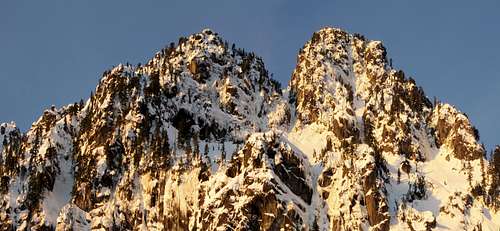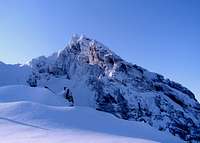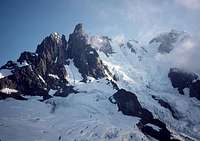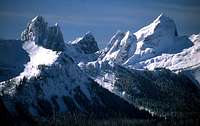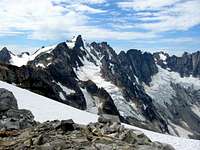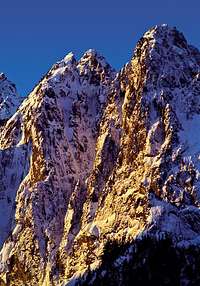-
 75570 Hits
75570 Hits
-
 85.09% Score
85.09% Score
-
 20 Votes
20 Votes
|
|
List |
|---|---|
|
|
Overview
This list of peaks, crags and towers is the crown jewel of Washington mountaineering. Originally compiled by Dallas Kloke, a well known alpinist from Washington, it was first completed by Tom Sjolseth on September 25, 2011. The peaks on this list will sure challenge you in every way and test all your skills you have learned. Everything from loose unprotected Class 5 rock climbing to steep near vertical bushwhacking to steep snow and ice climbing will be required to complete the list. Coming upon solid rock will be a welcome reprieve. It can take years to build the skill and confidence to climb even just one of these peaks and they are to be taken very seriously. Although the list covers the major peaks of Washington, most peaks on the list are merely subsidiary summits or towers of higher neighbors. This brings us to the question of what a major peak really is...thus making the list somewhat subjective. Add to that what some climbers think is hard others may not however this list was compiled by locating the top 10 most difficult peaks to reach by their standard routes taking both rock and snow/ice difficulty into account. Some people look at this list and dream about future adventures while others gawk in horror. No matter what your disposition may be, everyone can agree on one fact that these are beautiful, aesthetic peaks that characterize what the Washington Cascades are known for...the premier low-altitude mountaineering destination for climbers around the world.
The List
Below is the list...one day I will finish it. However for now I can only train, prepare and simply get better.
| Difficulty Rank | Photo | Peak | Brief Description |
|---|---|---|---|
| 1 | Middle Index | Middle index is regarded as the hardest summit to reach in all of Washington. It sits between the Main Peak and the North Peak (also on this list!) on the Index Massif. The Index Traverse is the most feasible way to climb it but this route is likely one of the most serious traverses in the state. This traverse involves constant exposure of over 4000 feet to each side, extensive 5.9 climbing on rock with little protection at times, and very committing rappels. Retreat on this traverse is not an option. You either finish it or die. It's as simple as that (Although you might be able to get airlifted off in an emergency) and your skills and mental strength will be tested. You have been warned. | |
| 2 | Lincoln Peak | Lincoln Peak is a subsidiary peak of Mount Baker and requires sustained climbing up 60+ degree snow and ice to reach the summit. This peak has a short climbing season during late spring and early summer when the snow is in good condition. However since the route is south facing, rock and ice fall is a very real danger when the sun comes up. It is best to make an ascent during the night, which means you must know the route beforehand. It would be imperative you be on your way down shortly after sunrise or climb it on a calm cloudy day. Once again, you have been warned. | |
| 3 | Nooksack Tower | This sub-peak of Mount Shuksan is a beautiful spire but hiding dangerous loose rock. The easiest route involves a long avalanche prone couloir climb of 60+ degree snow followed by many pitches of loose class 3 to class 5.6 rock which will provide considerable objective hazards. Approach this peak with a plethora of experience on loose rock...maybe get comfortable with doing laps up and down Boston Peak first. | |
| 4 | Inspiration Peak | This peak is located within the heart of the Picket Range deep in North Cascades National Park. It is one of the most remote on the list and requires a multi-day approach. Add to that you must carry all your technical gear on that approach and you have a real adventure waiting. The easiest route on this peak is the 5.6 west ridge which does have some loose rock. | |
| 5 | Hozomeen Mountain South Peak | This peak is located at the western margin of the Pasayten Wilderness and the northern end of Ross Lake. Like Inspiration Peak, it is very remote and climbers usually take the ferry service up Ross Lake to access it. The easiest route heads up the SW face on loose rock. Lots and lots of exposed loose climbing is required. | |
| 6 | Mount Fury West Peak | The west peak of Mount Fury is higher than the east peak by only a handful of feet however most people who climb Fury only make it to the much easier east peak. The traverse between the two is likely the best way to climb it and involves 5.6 climbing on halfway decent rock. This area is probably the most remote spot in all the lower 48 states. The only place I can think of that compares is the northern part of Dinosaur National Monument east of the green river and north of the Yampa River. Believe me when I say I have done extensive research about this subject. | |
| 7 | Hard Mox | This peak can either be a joy or your worst nightmare depending on your disposition. It is the hardest peak on the Bulger List (WA Top 100) and the only Bulger on this list. Peak-baggers in Washington going after the Bulgers must be able to rock climb because of this peak (among some other easier ones). The standard "Ridge of Gendarmes" is called that for a reason. If you treat this 5.7 climb with respect it can be an experience you will remember your entire life. The approach alone can be a memorable trip as you start in Canada! | |
| 8 | North Index | The Index massif is so rugged it has two spots on this list. The North Peak sits right next to the Middle Peak. The most common way up the North Peak is the 5.6 rated north face route. Even though all of the Mount Index massif sits below 6000 feet in elevation, the vertical relief is incredible. They rise over 5000 feet from Sky Valley where the highway passes through. From Highway 2 in the valley below you can look up to these peaks for inspiration. Don't let the low elevation fool you as these peaks are ten times more difficult than any of the high elevation volcanoes. | |
| 9 | Johannesburg Mountain | This peak is the only standalone mountain on this list with all others being subsidiary peaks. One can argue Hard Mox as its own mountain but not when compared to the massive size of Johannesburg. Towering above Cascade Pass in North Cascanes National Park, the north face of this mountain is one of the most striking in the country. Viewed from Boston Basin across the valley you can really get a feel how massive it really is. There is a handful of great routes up this peak including the 5.7 rated NE Rib or the C-J Couloir. The nice thing about this peak is that the approach is very short from the Cascade Pass Trailhead. | |
| 10 | Burgundy Spire | This spire is a sub-peak of the Silver Star massif near Washington Pass. This is only one of many, many towers in the area known as the Wine Spires. The rock here is superb and this might be the most enjoyable peak on this list to climb from a rock quality standpoint. Up to 10 pitches of beautiful 5.8 climbing brings you to a glorious summit. |
External Links
See Tom Sjolseth's Trip Report explaining his accounts about each peak.
Some people argue there are two other peaks that should be either included or replace some on this list. These two peaks are Assasin Spire and Gunsight Peak. Tom Sjolseth made the first ascent of Assasin Spire which is located on the Mount Baker massif near Lincoln Peak and stated it was more difficult than Lincoln so perhaps it should be included. Gunsight Peak located in a very remote location behind Sinister Peak has seen few ascents. It takes long enough to get to Sinister Peak on the Ptarmigan Traverse and adding Gunsight Peak where the easiest route may even be harder than 5.8 makes it worthy of this list. Nevertheless, the above list is as Dallas Kloke originally made it. Whether you agree with his decisions or not is up to you. Go climb them all and find out for yourself.


